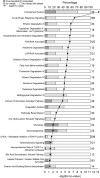Bronchoalveolar Lavage Fluid Protein Expression in Acute Respiratory Distress Syndrome Provides Insights into Pathways Activated in Subjects with Different Outcomes
- PMID: 28785034
- PMCID: PMC5547130
- DOI: 10.1038/s41598-017-07791-8
Bronchoalveolar Lavage Fluid Protein Expression in Acute Respiratory Distress Syndrome Provides Insights into Pathways Activated in Subjects with Different Outcomes
Abstract
Acute respiratory distress syndrome (ARDS) is associated with high mortality. We sought to identify biological pathways in ARDS that differentiate survivors from non-survivors. We studied bronchoalveolar lavage fluid (BALF) from 36 patients with ARDS (20 survivors, 16 non-survivors). Each sample, obtained within seven days of ARDS onset, was depleted of high abundance proteins and labeled for iTRAQ LC-MS/MS separately. Protein identification and relative quantification was performed employing a target-decoy strategy. A variance weighted t-test was used to identify differential expression. Ingenuity Pathway Analysis was used to determine the canonical pathways that differentiated survivors from non-survivors. We identified 1115 high confidence proteins in the BALF out of which 142 were differentially expressed between survivors and non-survivors. These proteins mapped to multiple pathways distinguishing survivors from non-survivors, including several implicated in lung injury and repair such as coagulation/thrombosis, acute phase response signaling and complement activation. We also identified proteins assigned to fibrosis and ones involved in detoxification of lipid peroxide-mediated oxidative stress to be different in survivors and non-survivors. These results support our previous findings demonstrating early differences in the BALF protein expression in ARDS survivors vs. non-survivors, including proteins that counter oxidative stress and canonical pathways associated with fibrosis.
Conflict of interest statement
The authors declare that they have no competing interests.
Figures

Similar articles
-
Proteome Profiling in Lung Injury after Hematopoietic Stem Cell Transplantation.Biol Blood Marrow Transplant. 2016 Aug;22(8):1383-1390. doi: 10.1016/j.bbmt.2016.04.021. Epub 2016 May 5. Biol Blood Marrow Transplant. 2016. PMID: 27155584 Free PMC article.
-
Proteomic profiles in acute respiratory distress syndrome differentiates survivors from non-survivors.PLoS One. 2014 Oct 7;9(10):e109713. doi: 10.1371/journal.pone.0109713. eCollection 2014. PLoS One. 2014. PMID: 25290099 Free PMC article.
-
Unique patterns of lower respiratory tract microbiota are associated with inflammation and hospital mortality in acute respiratory distress syndrome.Respir Res. 2019 Nov 6;20(1):246. doi: 10.1186/s12931-019-1203-y. Respir Res. 2019. PMID: 31694652 Free PMC article.
-
Mass Spectrometry-based Proteomics in Acute Respiratory Distress Syndrome: A Powerful Modality for Pulmonary Precision Medicine.Chin Med J (Engl). 2016 Oct 5;129(19):2357-64. doi: 10.4103/0366-6999.190669. Chin Med J (Engl). 2016. PMID: 27647196 Free PMC article. Review.
-
Shotgun MS proteomic analysis of bronchoalveolar lavage fluid in normal subjects.Proteomics Clin Appl. 2014 Oct;8(9-10):737-47. doi: 10.1002/prca.201300018. Proteomics Clin Appl. 2014. PMID: 24616423 Free PMC article. Review.
Cited by
-
Aldehyde metabolism governs resilience of mucociliary clearance to air pollution exposure.J Clin Invest. 2025 May 15;135(14):e191276. doi: 10.1172/JCI191276. eCollection 2025 Jul 15. J Clin Invest. 2025. PMID: 40408364 Free PMC article.
-
Beyond Anticoagulation: A Comprehensive Review of Non-Vitamin K Oral Anticoagulants (NOACs) in Inflammation and Protease-Activated Receptor Signaling.Int J Mol Sci. 2024 Aug 10;25(16):8727. doi: 10.3390/ijms25168727. Int J Mol Sci. 2024. PMID: 39201414 Free PMC article. Review.
-
Novel protein pathways in development and progression of pulmonary sarcoidosis.Sci Rep. 2020 Aug 6;10(1):13282. doi: 10.1038/s41598-020-69281-8. Sci Rep. 2020. PMID: 32764642 Free PMC article.
-
Personalized medicine using omics approaches in acute respiratory distress syndrome to identify biological phenotypes.Respir Res. 2022 Nov 19;23(1):318. doi: 10.1186/s12931-022-02233-0. Respir Res. 2022. PMID: 36403043 Free PMC article. Review.
-
Proteomic Analysis Revealed the Characteristics of Key Proteins Involved in the Regulation of Inflammatory Response, Leukocyte Transendothelial Migration, Phagocytosis, and Immune Process during Early Lung Blast Injury.Oxid Med Cell Longev. 2021 Apr 27;2021:8899274. doi: 10.1155/2021/8899274. eCollection 2021. Oxid Med Cell Longev. 2021. PMID: 34007409 Free PMC article.
References
-
- Ventilation with lower tidal volumes as compared with traditional tidal volumes for acute lung injury and the acute respiratory distress syndrome. The Acute Respiratory Distress Syndrome Network. The New England journal of medicine342, 1301–1308, doi:10.1056/NEJM200005043421801 (2000). - PubMed
Publication types
MeSH terms
Grants and funding
LinkOut - more resources
Full Text Sources
Other Literature Sources
Molecular Biology Databases

